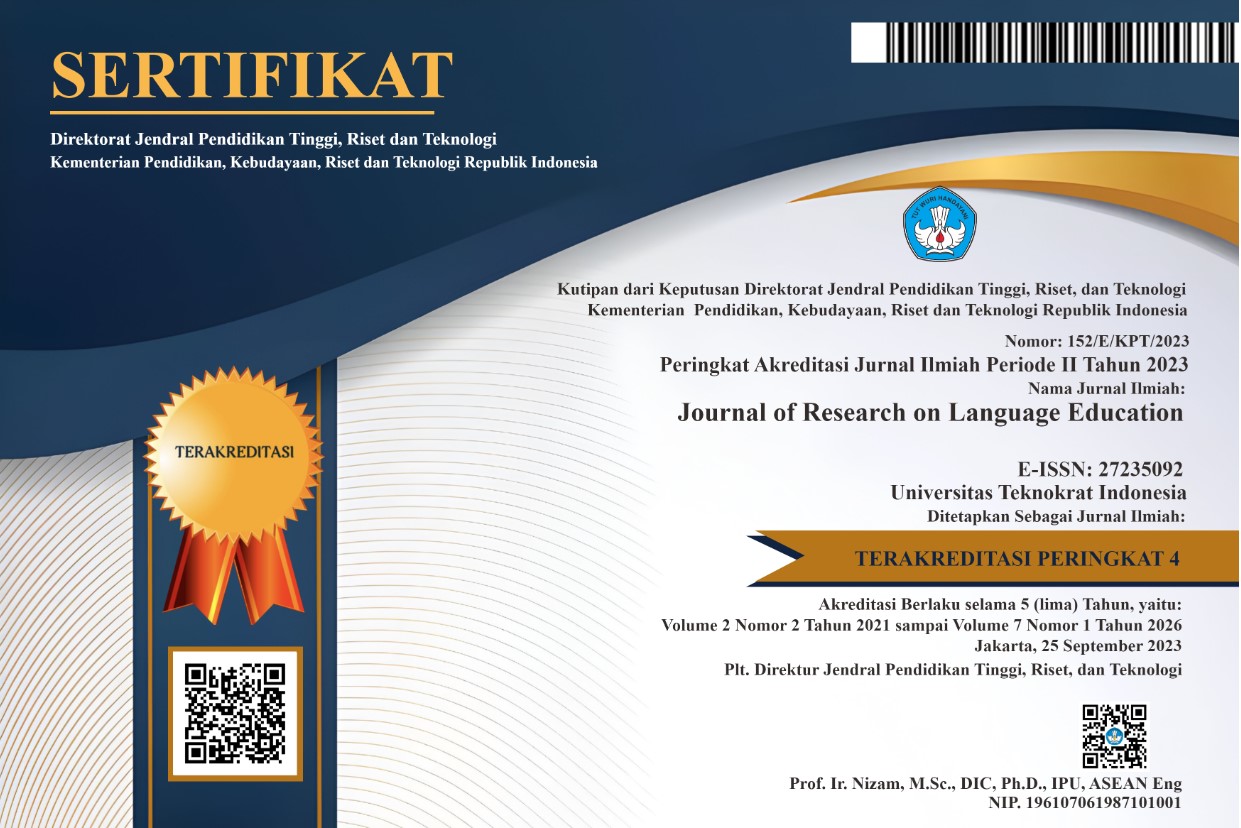THE IMPLEMENTATION OF EXTENSIVE READING TO FOSTER STUDENTS’ READING SKILL
Abstract
This paper aims to review some previous studies and theories related to the effect of extensive reading to boost students’ reading ability. Moreover, good reading ability is an important skill that should be mastered by students. It is used to enhance students’ knowledge and reading ability. However, students facing several difficulties in upgrading their reading skill, such as limited time to read, uninteresting reading materials given in the classroom, and unsupportive reading environment. Thus, this condition made students to have low reading ability. Extensive reading is chosen as a method to overcome students’ reading problems and difficulties. It is implemented by asking students to read as much as possible what they like outside the classroom. The purpose of this activity is to create supportive reading atmosphere for students. Furthermore, this paper will describe students’ difficulties in reading, the definition of extensive reading, and the advantages of implementing extensive reading in teaching reading. Extensive reading is also proven by some experts as an effective method to assist students reading challenges.
Keywords
Full Text:
PDFReferences
Bamford, J., & Day, R. R. (2000). Extensive Reading in the Second Language Classroom. Cambridge: Cambridge University Press
Bell, T. (1998). Extensive reading: why? And how? The Internet TESL Journal. Available at
<>
Brown, D. H. (2007). Principles of language learning and teaching (fifth edition). San Fransisco: Pearson Education, Inc
Carrel, P. L., & Carson, J. G. (1997). Extensive and Intensive Reading in an EAP Setting, English for Specific Purposes,16, 47-60.
Carvalho, J.B. (2001). Students’ difficulties when facing new literacy practices at post graduate levels, 17th European Conference on Reading Proceedings, page: 183
Day, R. R. & Bamford, J. (2002). Top ten principles for teaching extensive reading. Reading in a Foreign Language, 14(2), 136-141.
Day, R. R. and Bamford, J. (2004). Extensive Reading Activities for Teaching Language. Cambridge: Cambridge University Press.
Extensive Reading Foundation. Guide to Extensive Reading. http://www.erfoundation.org/ 2011.
Grabe, W. (2009). Reading in a second language: Moving from theory to practice (p. 328). Ernst Klett Sprachen.
Harmer, J. (2002). The Practice of English Language Teaching, 3 ed. London: Longman.
Joseph, L.M. (2001). Best practices on interventions for students with reading problems , The Ohio State University, Best practice in school psychology V, page : 1172 , Chapter 71 volume 4
Levy, L.S. 2016. Extensive Reading in English as a Foreign Language/ English as a Second Language Contexts. Research Report of the Department of Clinical Psychology, 2016, Episode 9
Liu, J & Zhang, J. 2018. The Effects of Extensive Reading on English Vocabulary Learning: A Meta-analysis. English Language Teaching, 11(6)
Loucky, J. P. (1996). Combining Intensive and Extensive Reading Strategies with Co-operative and Communicative Learn-ing Activities. Seinan Women’s Uni-versity. (Online). HTML: http://www.7.Tiki.ne.jp/-call4all/pdfiles/jo4-combining.pdf. (Accessed on 2 February 2010).
McLean, S., & Rouault, G. (2017). The effectiveness and efficiency of extensive reading at developing reading rates. System, 70, 92-106.
Miftah, M.Z. (2013). Implementation of Intensive-Extensive Reading Strategy to Improve Reading Comprehension. Journal on English as a Foreign Language 3(1):21-29
Nation, I. S. P. (2005). Teaching Reading and Writing. Student Notes Distribution Center. School of Linguistics and Applied Language Studies. Victoria University of Wellington
Ng, Q. R., Renandya, W., Chong, M. Y. C. 2019. Extensive Reading: Theory, Research, and Implementation. TEFLIN Journal, 30 (2)
Pearson, P. D., & Fielding, L. (1991). Comprehension Instruction. In R. Barr, M. Kamis, P. Mosenthal, & P. Pearson (Eds.), Handbook of Reading Research (vol.11;pages 815 860). White Plains, NY: Longman.
Renandya, W. A. (2016). Should you be teaching reading intensively or extensively? In D. Shaffer & M. Pinto (Eds), Proceedings of the 24th Annual Korea TESOL International Conference: Shaping the Future: With 21st Century Skills, 31-39. Seoul, Korea: KOTESOL
Ricahrds, J. C., & Schmidt, R. (2002). Longman Dictionary of Language Teaching and Applied Linguistics (3rd ed.).
Ruzin, M. (2019). Implementing Extensive Reading to Boost Students’ Reading Ability. Proceeding of Conference of English Language and Literature (CELL)
Satriani, E. 2018. Reading Comprehension Difficulties Encountered by English Students of Universitas Islam Riau. J-SHMIC, 5(2)
Sheu, S. P.-H. (2003). Extensive reading with EFL learners at beginning level. TESL Reporter, 36, 8–26.
Sweet. A. P. (2000. Ten Proven Principles for Teaching Reading. Online . Available on http: nea.org assets ... mf 10proven.pdf . Retrieved July 22, 2021.
Takase, A. (2007). Japanese High School Students’ Motivation for Extensive L2 Reading. Retrieved 7 August 2021
DOI: https://doi.org/10.33365/jorle.v4i1.2544
Refbacks
- There are currently no refbacks.

This work is licensed under a Creative Commons Attribution-NonCommercial-ShareAlike 4.0 International License.

Articles published in Journal of Research on Language Education is licensed
under a Creative Commons Attribution-ShareAlike 4.0 International License.
English Education Study Program, Faculty of Arts and Education.
Universitas Teknokrat Indonesia
Zainal Abidin Pagaralam 9-11 Bandar Lampung, Indonesia
All rights reserved.








